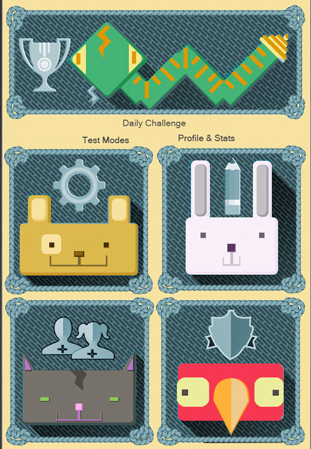Target Outcome: Demonstrable improvement of Working Memory and evidence of transfer
Target Audience: children ages 6-10
Genre: Action-Puzzle
Art Examples: Ulm
Fun Factor: Collecting, customizing, sharing, being immersed in a singular appealing fantasy world
Motivation for Play/Re-Play: Completionist categories, ability to build and personalize world, Adaptivity: use of algorithms to dynamically adjust challenge level [difficulty settings] of mechanics or puzzle per round
Unique Characteristics:
- hybrid between popular entertainment games and learning software
- overarching story to immerse players
- ease of adding content for world expansion
- ease of adding mechanics through mini-games to increase depth and breadth of scope
- competitive encouragement and self-measurement through social interaction [but multiple paths to success to maintain positive attitude]
=== WORLD DESIGN ===
Incredible Creature-torium! Rescue unique and adorable creatures from around the world. Build one of a kind habitats for each of your creatures and feed them their favorite foods while you look after them. Encourage friends to visit, and visit their sanctuaries too. Will you find some of the rarest of the creatures for your reserve? Want to have one of every rescued creature to keep your sanctuary in balance — then exchange with friends! There’s a lot to do to keep all these amazing creatures happy — so let’s get starting making your Incredible Creature-torium!
Why “creatures”? The visual and world building are based on a ‘skinning’ approach. Perhaps we will find the target audience reacts more favorably to robots or animals in a pirate or space world. Or perhaps there could be a subset of creatures released that are based on the various worlds that the player visits and could include more accurate, realistic creatures relating to a school lesson — i.e. sea creatures, forest mammals, aquatic birds, etc.
The core of the game mechanics and design remain the same, but appeal factor is easily altered through visual and auditory style.
=== WORLD MECHANICS ===
- Feed [cool foods] — makes full
- Upgrade decorations [cool items] — makes happy
- Upgrade habitats [cool backgrounds]
- Collect new animals [cool creatures]
- Collect special creatures [rare ones]: just a small chance of whether what you collect is rare or regular
- View your zoo
- View other zoos
- Trade creatures if you both have duplicates. Except for Rares which you can trade for any other Rare even if no duplicates.
- Rank after each mini-game “Challenge a friend. Your score was better than xx% of played games so far.”
=== WORLD RULES ===
- You cannot add a creature until you have a habitat to hold it.
- You cannot add a creature even if you have an open habitat unless all of your other creatures are full and happy.
- Some cool food will satisfy for longer. [not seen after purchase]
- Some cool items will keep happy for longer. [may or may not be seen after use. they wear out]
- Cool habitats just look good in your zoo view — cosmetic only.
- You do not store food or items, instead use them when you get them.
- Use coins for habitats which you get at the end of each mini-game — amounts vary based on performance.
=== MINI-GAMES ===
To collect food, items, habitats, creatures [and coins in all of them], you must play the mini games. The better your score, the better your chances/probability to get ‘cool’ versions of the items.
How do you decide if they get food, items, habitats, or creatures though? The more often you go to play that mini-game within a 24 hour period, the more of the next type you get. So first 4 times, food. Next 4 times, items. Next 4, habitats. Next 4, creatures. Or at least increased probability.
Integrate adaptive algorithms so that player must score 80% or better on the round to see an increase or 50% or less to see a decrease in challenge of next round.
One Mini Game consists of 3 or 4 rounds and come from the following:
- N-back tests using pictures of various food items and decorative items
- Match the creature names to silhouettes
- See image of decorated habitat with N items staged in set places, then the player must drag from a top row of items, and drop them into the various set places to recreate the scene
- See food items with numbers that flash on them, so that a creature can eat them in order of his/her preference [story reason] but then to increase difficulty add more numbers
- See a series of ‘photos’ taken of food, items, and animals, flash in non-sequential order across the top. Then a larger central image flashes visible briefly below. Player must click on the ‘photo’ that matches.
- Recipe builder: recipes of ingredients to build favorite cool foods are presented. Player builds foods. Try to get them right, try to do them quickly to keep animals happy.
=== VISUALS ===
- Food and Items look like large emoticons.
- Habitats look similar to one another but with color and theme variations.
- Creatures comprised of 300 plus 50 rare and 10 super rare. Vector art style.
- Unowned creatures are silhouettes only, to encourage desire to find and collect.
